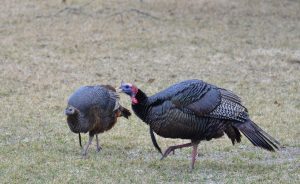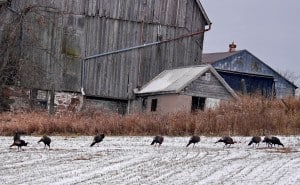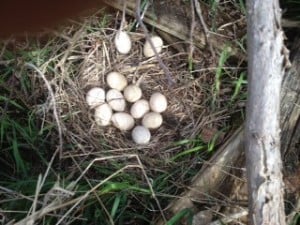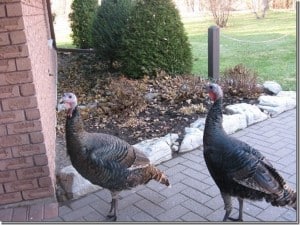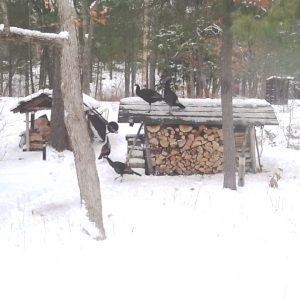Abundant Wild Turkeys entertain rural residents with their interesting behaviours.
It was a blockbuster trade for the ages. However, it wasn’t athletes that were shuffled around. It was wildlife. In 1984, Ontario sent River Otters to Missouri, Ruffed Grouse to New York and Moose to Michigan in exchange for 274 Wild Turkeys from all three states.
The last native Wild Turkey disappeared from Ontario more than 100 years ago. Habitat loss and unregulated hunting did them in. There were many attempts at reintroduction, including at least one in the 1960s with turkeys from Pennsylvania. It was spearheaded by ‘Turkey Jack’ Davis, a well-known outdoors writer who later moved to Peterborough. His daughter, Wendy, remembers a “garage full of turkeys” at their Port Credit home. These early attempts were never successful, unfortunately, because they used captivity-raised birds, which couldn’t adapt to life in the wild. However, thanks to the wide genetic spectrum of the turkeys acquired in 1984, this reintroduction was an astounding success.
Since then, Ontario’s turkey population has skyrocketed to about 100,000 birds. Most remarkably, they now range as far north as Algonquin Park and Sudbury, which is likely outside their historical range. Initially, there were fears that the climate would be too harsh, but the resilient turkeys proved the biologists wrong.
Catching the wild American birds was made possible by the development of a Howitzer-propelled net – a technology still used today. Jennifer Baici, a PhD student at Trent University who studies Wild Turkey social structure and behaviour, describes how the trapping works.” We begin by finding a flock and learning its schedule. This includes noting when the birds typically leave the roost, the path that they take throughout the day and what time they tuck in for the night. Turkeys are highly predictable in the winter, so we can make a plan about how to bait them. This involves intercepting their daily path with a ‘bait line’ of corn. We extend this line out into the middle of a field where we put down a large pile of corn. Once the flock is visiting the bait at roughly the same time each day, we set up a camouflaged net and wait for the turkeys to arrive. Although these birds are usually quite predictable, they still surprise us by occasionally sleeping in way later than expected!” To see a 10-second video of turkey trapping in action, click HERE.
A bird we notice
In researching this article, I contacted a number of people living out in Peterborough County for any turkey anecdotes they might have. As we’ll see, everyone had numerous stories. I should note, too, that turkeys often show up right in Peterborough.
Wild Turkeys are a striking bird. They have iridescent bronze-green feathers and bare skin on the head and neck, which can vary from to red to blue-grey. The bare skin probably plays a role in heat dissipation, since turkeys are essentially southern birds where hot weather is a challenge. Males – and very occasionally females – also have a bristly “beard” made of modified feathers that extend off the chest. Its purpose is poorly understood, but it may play a role in mate selection by the female.
In early spring, the toms (males) gather in clearings to perform courtship displays. They strut about gobbling with hormone-charged exuberance. Annamarie Beckel, who lives just south of Lakefield, has had a front row seat to the spectacle. “We woke up one May morning to find a tom and about six hens in our front yard. The hens were browsing in the grass, while the tom was displaying for all he was worth – the fully fanned tail, the fluffed up feathers and the dropped wing. The hens, of course, appeared to ignore him!”
The hens nest in hedgerows, along the edge of woodlots and sometimes in hayfields. The birds stay in family groups most of the summer. Sometimes two or three hens and their broods will join together. Winter flocks, however, are the largest. On average, a flock contains 25-50 birds, but sometimes there are many more. “In winter, we’ve seen large flocks of 100 or more in neighbouring fields,” says David Frank, who lives on Stewart Line near Cavan.
Turkeys are well-established north of Peterborough, too. Dennis and Lynn Johnson, who live on the north shore of Stony Lake, have been noticing them for at least 12 years. Across the lake on Dodsworth Island, Rob Welsh sees them there, too. “In winter, they parade between islands in more or less single file – a comical sight!”
At dusk, turkeys fly up into trees to roost for the night. For several years, Tim Dyson watched a flock that roosts in trees west of the junction of Preston Road and Fire Route 23 near his former home at Belmont Lake. One night he counted 118 turkeys lining the branches.
Diet
Turkeys eat just about everything. This includes acorns, beech nuts, hickory nuts, fruit, insects, worms, snails and even amphibians. Tom Northey of Little Britain told me of a hunter friend who was cleaning a bird and found Leopard Frogs in its crop. They will also eat crops such as wheat and corn, which does not go over well with farmers.
Turkeys can also turn up at backyard feeders. Dyson recalls a behaviour he dubbed the ‘Kenturkey Derby’. “The birds would see me go outside with a tub of bird seed. After I went back in the house, they would come running from 100 metres across the field to gorge themselves.” Dennis and Lyn Johnson’s Stony Lake birds will come right up and practically eat out of their hands.
Unfortunately, the turkey’s taste in foods can become problematic. Dennis explains. “Last year, my wife Lynn made her usual fall/winter outdoor pots of greenery. Included in the arrangement were several sumac heads. We’d never seen them eating sumac in the wild, but they sure enjoyed eating them from Lynn’s arrangement. After replenishing the sumac three or four times, Lynn decided that the turkeys could go down the road and get their own!”
Predators
An abundance of nutritious turkey meat has not gone unnoticed by predators. Several people I emailed have seen coyotes stalking the birds. Raptors, too, are getting in on the action. Rick Stankiewicz of Keene writes, “On the edge of an open field at daybreak, I watched as a Great Horned Owl attacked and tried to fly off with a turkey decoy!” Tom Northey saw a Northern Harrier grab one in a hayfield, and this past fall his daughter came across a Bald Eagle eating a turkey.
Tim Dyson watched a female Northern Goshawk attack one of eight wild turkeys as they fed on scattered seed behind a house. “Once the hawk had seized the much heavier turkey by the rump, the other turkeys quickly surrounded the two and put on a rather aggressive display by spreading their tails and dragging their wings in an manner not unlike their courtship display. This intimidation seemed to work, since the hawk soon released her grip and sped off. The turkey fared well – only minus a few feathers!”
The interplay between turkeys and competitors for food is also interesting. Rick Stankiewicz has seen numerous interactions between turkeys and White-tailed Deer.” They always seem curious and tolerant of each other, but not in a friendly or playful way.” Trent’s Jennifer Baici also has an interest in these interactions. She is studying flocks of turkeys that congregate with groups of deer and hopes to learn more about the social dynamics between the two.
Turkeys and geese also interact in curious ways. Laura Summerfeldt, who lives near Keene, writes: “A few years ago in late autumn, we saw an extraordinary spectacle. A flock of Canada Geese had settled in the corn field adjacent to our house. The resident flock of a dozen or so turkeys withdrew to the hedgerow. The geese stayed on. The next afternoon we happened to be watching and observed that the turkeys “rallied” and en masse CHARGED the flock of geese in an organized manner. With wings outspread, they ran across the field in a line. Truly, it was like a cavalry charge. They drove the geese to the far end of the field and then resumed feeding!”
Hunting
Thanks to their abundance, there is now both a spring and fall turkey hunt. In the spring, only males can be targeted. This puts less pressure on the population, since the toms are highly polygamous and can impregnate up to 15 hens. Hunting turkeys is not easy, however. Turkeys are extremely wary and have excellent eyesight and hearing. The success rate for both seasons is only one bird for every three hunters. For hunters who are successful, the meat is delicious and close to domestic turkey in taste.
Population study
Part of Jennifer Baici’s research is to investigate the usefulness of citizen science platforms such as eBird and iNaturalist in estimating turkey population size. This winter, she is running a pilot project in Peterborough County and is requesting turkey sightings that fall between December 1, 2017 and March 31, 2018. This can be done either by adding observations to eBird or by submitting photos of any flocks seen to the Peterborough Wild Turkey Count project on iNaturalist. You will need to sign up for the project first. Be sure to include where you saw the birds and how many there were. Eventually, Jennifer hopes to expand the project and explore whether citizen science platforms can be applied to estimate Wild Turkey population size for larger areas, such as the province of Ontario – so stay tuned.
